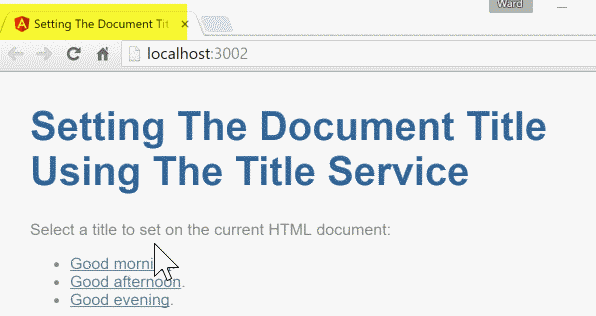Your app should be able to make the browser title bar say whatever you want it to say. This cookbook explains how to do it.
应用程序应该能让浏览器标题栏显示我们想让它显示的内容。本烹饪宝典解释怎么做。
See the
参见
To see the browser title bar change in the live example, open it again in the Plunker editor by clicking the icon in the upper right, then pop out the preview window by clicking the blue 'X' button in the upper right corner. 要在在线例子中看到浏览器标题的变化,请点击右上角的图标在Plunker编辑器中打开它,然后点击预览窗口右上角的蓝色'X'按钮,弹出窗口。 |   |
The problem with <title>
<title>的问题
The obvious approach is to bind a property of the component to the HTML <title> like this:
显而易见的方法是把组件的属性绑定到HTML的<title>标签上,像这样:
Sorry but that won't work.
The root component of the application is an element contained within the <body> tag.
The HTML <title> is in the document <head>, outside the body, making it inaccessible to Angular data binding.
抱歉,这样不行。我们应用程序的根组件是一个包含在<body>标签里的元素。该HTML的<title>在文档的<head>元素里,在<body>之外,Angular的数据绑定无法访问到它。
You could grab the browser document object and set the title manually.
That's dirty and undermines your chances of running the app outside of a browser someday.
可以从浏览器获得document对象,并且手动设置标题。但是这样看起来很脏,而且将无法在浏览器之外运行应用程序。
Running your app outside a browser means that you can take advantage of server-side pre-rendering for near-instant first app render times and for SEO. It means you could run from inside a Web Worker to improve your app's responsiveness by using multiple threads. And it means that you could run your app inside Electron.js or Windows Universal to deliver it to the desktop.
在浏览器外运行应用程序意味着:利用服务器端预先渲染,为应用程序实现几乎实时的首次渲染,同时还能支持SEO(搜索引擎优化)。 意味着你可以在一个Web Worker中运行你的应用程序,通过多线程技术增强应用程序的响应性。 还意味着你可以在Electron.js或者Windows Universal里面运行,发布到桌面环境。
Use the Title service
使用Title服务
Fortunately, Angular bridges the gap by providing a Title service as part of the Browser platform.
The Title service is a simple class that provides an API
for getting and setting the current HTML document title:
幸运的是,Angular在浏览器平台的包中,提供了一个Title服务,弥补了这种差异。
Title服务是一个简单的类,提供了一个API,用来获取和设置当前HTML文档的标题。
getTitle() : string—Gets the title of the current HTML document.getTitle(): string—— 获取当前HTML文档的标题。
setTitle( newTitle : string )—Sets the title of the current HTML document.setTitle( newTitle: string)—— 设置当前HTML文档的标题。
You can inject the Title service into the root AppComponent and expose a bindable setTitle method that calls it:
我们来把Title服务注入到根组件AppComponent,并暴露出可供绑定的setTitle方法让别人来调用该服务:
src/app/app.component.ts (class)
Bind that method to three anchor tags and voilà!
我们把这个方法绑定到三个A标签,瞧瞧!

Here's the complete solution:
这里是完整的方案(代码)。
Why provide the Title service in bootstrap
为什么要在bootstrap里面提供这个Title服务
Generally you want to provide application-wide services in the root application component, AppComponent.
我们通常会推荐在应用程序的根组件AppComponent中提供应用程序级的服务。
This cookbook recommends registering the title service during bootstrapping, a location you reserve for configuring the runtime Angular environment.
但这里,我们推荐在引导过程中注册这个Title服务,这个位置是为设置Angular运行环境而保留的。
That's exactly what you're doing.
The Title service is part of the Angular browser platform.
If you bootstrap your application into a different platform,
you'll have to provide a different Title service that understands
the concept of a "document title" for that specific platform.
Ideally, the application itself neither knows nor cares about the runtime environment.
我们的做法正是如此。这里的Title服务是Angular浏览器平台的一部分。如果在其它平台上引导应用程序,就得提供另一个专为那个平台准备的Title服务。